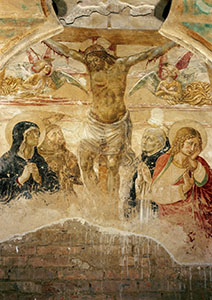
Tabernacle of Legoli, Crucifixion.
In 1468, Benozzo was called to Pisa to paint frescoes for the Camposanto (graveyard), a work he completed in 1484. As demonstrated by documents kept in the archives of Pisa’s Opera Primaziale (the lay institution responsible for the construction and preservation of the Cathedral and Camposanto buildings), from May 1479 to January 1480, Benozzo resided in Legoli, now a small village outside the town of Peccioli, to escape the plague that had struck Pisa during that period. It is highly probable that, during his time there, he produced the majestic Tabernacle still situated today at the entrance to the village and frescoed on all four walls. A Sacra Conversazione with curtain-bearing angels is depicted on the back wall, while the extradoses of the arch of the main façade are frescoed with the Annunciation, and the intrados bears the Evangelists and the Fathers of the Church with a Christ in the act of blessing in the centre. On the right-hand wall there is a Christ carrying the cross, now extremely fragmentary, within a cusped arch, and an ornate two angels in the extrados. The left-hand wall façade is decorated externally with a pair of angels, below which is the Archangel Michael (on the left) and Saint Thomas incredulous (on the right), and the main scene, within the multi-cusped arch, depicts a Crucifixion with saints. The north wall of the Tabernacle, which is most exposed to storms and therefore particularly damaged, was frescoed with the Martyrdom of Saint Sebastian.
In 1822, Alesso della Fanteria erected a small funeral chapel, dedicated to Saint Catherine, to project around the Tabernacle to protect it.
Serena Nocentini